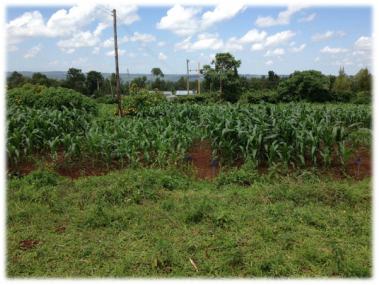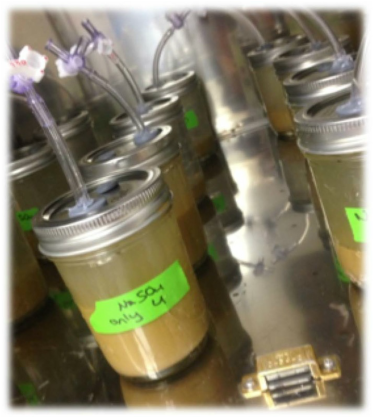|
As the world’s population continues to grow, a key issue facing society is how to balance feeding the world while protecting the environment. Dr. Kate Tully has worked on this problem in both East Africa and the United States, where the solution will require different approaches, in part due to the different use of crops. In developed nations, many grain crops are grown for animal feed and fuel compared to developing nations where most are grown for human consumption. As such, different goals and approaches need to be taken for a sustainable future. While crop yield has increased in many parts of world since the 1960s, this trend has not occurred in sub-Saharan Africa. Dr. Tully is working in Kenya and Tanzania to determine what changes can improve yield without excessive fertilizer use. Africa as a whole plans to increase nitrogen-based fertilizer use, but there is an upper limit to the amount plants can use before the rest is lost to the environment.
Large amounts of fertilizer nitrate were leached through the sandy soils to groundwater. Dr. Tully concluded that, in addition to using better overall management practices such as irrigation and increasing organic matter content, site characteristics should determine the optimal nitrogen fertilizer amount; in these cases, farmers in Kenya can increase yield by adding 75-100 kg N/ha while those in Tanzania should only use 50 kg N/ha. These levels can increase yield while protecting the environment from excess nitrogen leaching into waterways and gassing off into the air. Back in the U.S., Dr. Tully turned her attention to soil nutrient dynamics on the Eastern Shore, Maryland. The dominant agricultural crops feed—corn and soybeans support their primary industry—poultry. Over the years, phosphorus from fertilizers and chicken litter has accumulated in the soil to the point of saturation. Phosphorus typically binds to soil particles with minimal nutrient leaching to the surrounding environment. Yet, as human-accelerated sea-level rise causes saltwater intrusion of coastal farmland, soil dynamics are changing. Saltwater can significantly alter soil chemistry, which may result in the release of bound soil nutrients as runoff. While nitrogen and phosphorus are essential nutrients for living organisms, too much can throw entire ecosystems off balance. Excess phosphorus in particular has led to algal blooms in fresh water estuaries. Over time algal blooms deplete life supporting oxygen resulting in ‘dead zones.’ But to what magnitude, rate, and extent are saltwater intrusions increasing the movement of phosphorus?
Read more of Dr. Tully’s work!
Tully K, Hickman J, McKenna M, Palm CA, Neill C. 2016. Effects of increased fertilizer application on inorganic soil N in East African maize systems: vertical distributions and temporal dynamics. Ecological Applications 26: 1907-1919. doi:10.1890/15-1518.1 Becca Eckert is a Ph.D. student in Bill Lamp’s lab. Her research examines how changes in light and nutrient availability affect macroinvertebrate growth and diversity in heterotrophic headwater streams as mediated by changes in leaf-associated algal quantity and quality. Lisa Kuder is a Ph.D. student in Dennis vanEngelsdorp’s Bee Lab. Her research focuses on road ecology, specifically improving highway rights-of-way for pollinators. Comments are closed.
|
Categories
All
Archives
June 2024
|
Department of Entomology
University of Maryland
4112 Plant Sciences Building
College Park, MD 20742-4454
USA
Telephone: 301.405.3911
Fax: 301.314.9290
University of Maryland
4112 Plant Sciences Building
College Park, MD 20742-4454
USA
Telephone: 301.405.3911
Fax: 301.314.9290



 RSS Feed
RSS Feed




